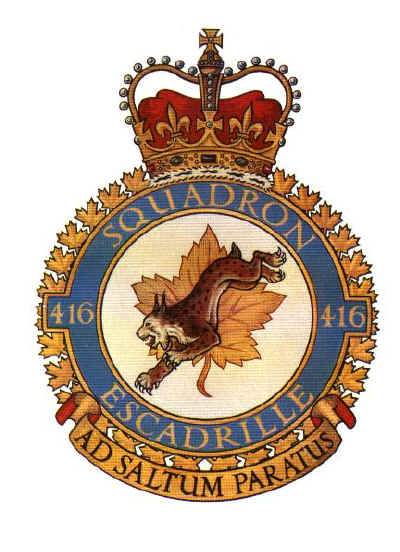

|
416 (F) Squadron OCs |
|
|
S/L J "John" MacKay, DFC and Bar |
Mar 52 - Aug 54 |
|
S/L KC "Ken" Lett |
Oct 54 - Mar 56 |
|
S/L JLA "Joe" Rousell, DFC |
Mar 56 - Jan 57 |
416 Squadron History
On January 15, 1951, after five years of inactivity, 416 Squadron was reformed as a fighter unit of the regular forces within the Air Defence Group. Located at RCAF Station Uplands, the Squadron began flying North American P-51 Mustangs. The first jet aircraft flown by 416 Squadron was the Lockheed T-33 Silver Star I. During the period of early 1952, serious jet instruction and high altitude indoctrination were undertaken in preparation of becoming a jet fighter unit. This was realized in April 1952 when 416 received Sabre aircraft and prepared to transfer to Grostenquin, France.
The squadron proceeded overseas as part of Operation "Leapfrog II" between 28 September and 1 October 1952, arriving at 2 (F) Wing Grostenquin France on 11 October 1952.
Located in Grostenquin France, just 190 miles from the Russian border of East Germany, flying MK-2 Sabres, 416 Squadron formed part of the Canadian contribution to NATO. During this period, updated models of MK-5 followed by MK-6 Sabres were received, and the Squadron participated in deployments to Gardenour, Norway, Rabat in the French Morocco and Baden-Soellingen, Germany. In January 1957, due to changes in the Canadian contributions to NATO, 416 Squadron was deactivated at Grostenquin on 31 January 1957.
Operational Callsign
unknown
Squadron Nickname
Black Lynx
Aircraft Identification Markings
The letters "AS"
Aircraft Flown
|
Canadair Sabre Mk. 2 |
Mar 52 - Mar 54 |
|
Canadair Sabre Mk. 5 |
Mar 54 – May 55 |
|
Canadair Sabre Mk. 6 |
Apr 55 - Jan 57 |